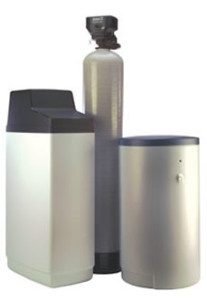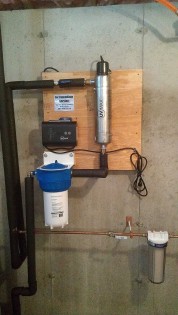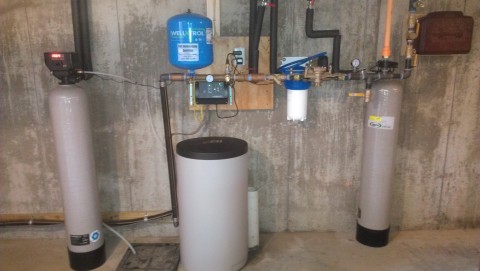 WE OFFER THREE TYPES OF WATER TREATMENT SYSTEMS
WE OFFER THREE TYPES OF WATER TREATMENT SYSTEMS
There are three types of water treatment systems commonly used in private homes to treat water for a variety of contaminants: water filtration, reverse osmosis and ion exchange. It may be necessary to remove a contaminant because it’s unhealthy to consume. Some examples are arsenic, uranium, E. coli, coliform bacteria & nitrates. Or you may want to remove something that is simply undesirable because it changes the taste or smell of your water, makes your water hard, or stains your fixtures or clothing. Some examples are: Iron, manganese, calcium and magnesium.
WATER FILTRATION
Water Filtration is the simplest method of treating water. Water is forced through some physical barrier, with larger particles either “sticking” to the media, or they simply can’t fit through the pore spaces in the media and are “trapped”. Activated carbon filters have tremendous surface areas for contaminants to adhere to. They are effective at removing many contaminants that change the taste and odor of water, especially organic compounds. Carbon filters are not effective at removing most inorganic compounds and should not be relied upon to remove arsenic, nitrates, or other inorganics. Finally, filters should not be used to remove anything that’s dissolved in water. It was a chemical reaction that caused the contaminants to dissolve, and will likely require a chemical reaction (ion exchange) or filtration at the atomic scale (reverse osmosis) to remove.
ION EXCHANGE
Ion exchange involves the swapping of an undesirable ion in your water with one that has similar chemical properties, but does not have negative effects on water quality. Water softeners are the most common ion exchange systems in use in most homes. Ion exchange systems can also remove iron, manganese, nitrates and if properly designed, arsenic and uranium. An ion is any atom or compound that has either a positive (cation) or negative (anion) charge, like the poles on a magnet. A positive ion will be attracted to a negative charge in the same way the “north” pole of a magnet is attracted to the “south” pole of another magnet. The “magnet” in these systems is usually a man made polystyrene resin. The process begins with thousands of resin beads with sodium cations attached. As water passes through the resin beads, cations like iron, manganese, or calcium, knock the sodium cations off and replace them. This is possible because the sodium cations have a weaker charge. After a period of time, the available locations for this exchange to take place start to be used up. At this point the system will “regenerate” itself. A brine solution is washed over the resin beads and the billions of sodium cations in the solution force themselves back into place, removing the iron, calcium, or other cations, and flushing them into a septic system or sewer.
REVERSE OSMOSIS
Reverse osmosis (RO) can be loosely thought of as atomic scale filtration. It works by squeezing water through a special membrane. The membrane has microscopic holes, which are specially sized to allow relatively small water molecules to pass through, while trapping larger inorganic elements like lead, iron, chromium, and arsenic or organic compounds. Studies have shown RO to be up to 95% effective at removing the most common form of arsenic routinely found in Maine well water. RO requires very little regular maintenance, no chemical addition, is very reliable, and installation is fairly straightforward. The RO system most homeowners have installed is a point of use system, designed to treat only a small amount of water daily. It is usually located near the kitchen sink, and is capable of producing two or three gallons of treated water per day. It consists of a particulate pre-filter which removes sand and grit, the membrane where the reverse osmosis occurs, and an activated carbon polishing filter to aid in taste and odor control. Treated water is stored in a small tank, and is accessed through a faucet located next to the regular kitchen faucet.



